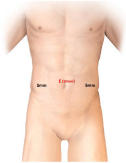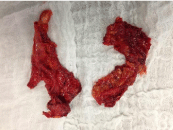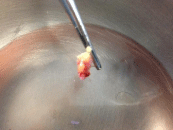Case Report
Removal of Polypropylene Mesh by Chronic Inguinodinya after Inguinal Laparoscopic Hernioplasty: A Case Report
Maurice Youssef Franciss, Thayla Kruger Amaral, Mauricio Correia Mauad and Leandro Cardoso Barchi e Bruno Zilberstein*
Department of Digestive Surgery, Gastromed Instituto Zilberstein, São Paulo, Brazil
*Corresponding author: Leandro Cardoso Barchi e Bruno Zilberstein, Gastromed Instituto Zilberstein, Av. Nove de Julho, 4440 - Jardim Paulista, São Paulo - SP, 01406- 100, Brazil
Published: 20 Apr, 2017
Cite this article as: Franciss MY, Amaral TK, Mauad
MC, Barchi e Bruno Zilberstein LC.
Removal of Polypropylene Mesh by
Chronic Inguinodinya after Inguinal
Laparoscopic Hernioplasty: A Case
Report. Clin Surg. 2017; 2: 1418.
Abstract
Background: Chronic pain in the inguinal region after hernia repair (inguinodynia) is an uncommon complication that results in pain and paresthesia at the operated site.
Case Report: A 46 years old male, submitted to laparoscopic bilateral inguinal hernioplasty that
evolved with bilateral inguinodynia. The patient was successfully treated with the removal of the
mesh by laparoscopy and did not have hernia recurrence.
Discussion: Inguinodynia affects a restricted group of patients after hernia repair. The best way
to manage chronic postoperative pain is to prevent its manifestation. Therefore, the anatomical
knowledge of the inguinal region is the cornerstone, combined with the proper manipulation and
dissection of tissues and the correct use of fixation materials.
Introduction
Chronic pain in the inguinal region after hernia repair (inguinodynia) is an uncommon
complication that results in pain and paresthesia at the operated site, and may be irradiated to the
regions surrounding the inguinal canal [1]. However, the types of postoperative pain should be
differentiated. They are: neuropathic or neuralgic pain (injury of the ilioinguinal, iliohypogastric and
genitofemoral nerves), somatic pain (ligament insertions in the pubic tubercle) and "disejaculation or deafferentation" (painful sensation during ejaculation), the last one being less frequent [2].
The treatment of this complication is done through: non-hormonal anti-inflammatory drugs,
and it may be associated with drugs for chronic neuralgia such as amitriptyline [1]; Cryoablation [3] or even removal of the prosthesis when the symptoms persists or conservative treatment fails.
Case Presentation
A 46 years old male, submitted to laparoscopic bilateral inguinal hernioplasty that evolved
with bilateral inguinodynia. The patient presented pain on the inner thigh since the immediate
postoperative period, even at rest, bilaterally, more intense to the right, with irradiation to the
testicles. It was performed a magnetic resonance imaging (MRI), which demonstrated possible
neuroma in the lateral portion of the rectus abdominis muscle on the right, with no other findings.
Initial clinical treatment with non-hormonal anti-inflammatory, corticosteroids, and neuralgia
medications (carbamazepine and amitriptyline) for three months had no effect. As an alternative,
anesthetic block with ilioinguinal, iliohypogastric and genitofemoral bupivacaine was performed,
however without success. After therapeutic failure, a new surgical intervention was indicated for
prosthesis removal.
The patient was submitted to laparoscopy 6 months after his first surgical intervention. The
portals were placed in usual position for inguinal hernioplasty according to Figure 1. Peritoneal opening was performed bilaterally, with dissection of the structures until the mesh was identified.
After a meticulous dissection and release of adhesions and fibrotic tissues adjacent to the prostheses
their removal was achieved, as well as all the surgical tacks inserted in the previous surgery and
were noticed that some of them had a formation of granulomas (Figures 2 and 3). After revision
of hemostasis the integrity of the bilateral inguinal canal and its structures were confirmed. It was
decided for the synthesis of the peritoneum to use glue based on n-butyl-2-cyanoacrylate in order
to promote good hemostasis and avoid the placement of new foreign bodies (tacks), thus reducing
the patient's chance to remain with postoperative pain. The patient evolved satisfactorily and was
discharged in the first post-operative day. The patient reported a significant improvement in pain at the time of hospital discharge. After 12 months of follow-up, he showed no signs of recurrence of neither hernias nor inguinodynia.
Figure 1
Figure 2
Figure 3
Discussion
Postoperative inguinal pain gained importance since laparoscopic
intervention decreased this incidence, allowing better and faster
postoperative recovery [2]. However, inguinodynia affects a restricted
group of patients, both in open surgeries or through video surgery,
which continue to be subject of debate regarding the best therapeutic
management.
The nerves involved in the genesis of inguinodynia of neuropathic
origin correspond to the lumbar plexus. The nerves that are injured
in open surgery in order of frequency are: the ilioinguinal nerve,
ilio-hypogastric and genital branch of the genitofemural nerve. In
laparoscopic approaches, the most frequent lesions occur in the
branches of the femorocutaneous and ilio-inguinal nerves [4,5].
The diagnosis for inguinodynia is basically clinical and can be
complemented by imaging tests such as computed tomography and
MRI. An "objective" tool of great value is mapping by dermatomes, a
technique that allows the evaluation of pain intensity and, above all,
the type of dysesthesia present and the nerve branches involved [5].
Management of the patient with chronic inguinal pain depends
on an accurate diagnosis. Somatic pain cases usually are relivied with
the administration of analgesics and oral anti-inflammatories as well
as neuropathic events [1,6]. If the pain continues, infiltration of the
involved branches and trigger points determined on dermatome
exploration must be performed with 2% lidocaine associated with
corticosteroid every 2 weeks for 3 sessions. In case of symptoms
persistence, removal of the prosthesis or the triple neurectomy may
be indicated [1].
The best way to manage chronic postoperative pain is to prevent
its manifestation. Therefore, the anatomical knowledge of the inguinal
region is the cornerstone, combined with the proper manipulation
and dissection of tissues and the correct use of fixation materials.
There is a great discussion about the use of materials for fixation and
closure of the peritoneum (tacks, absorbable suture or glue). In this
context, the technique of totally extraperitoneal hernioplasty (TEP)
would have a slight advantage over the transabdominal technique
(TAPP) because there is no opening, and consequently, the need for
peritoneal closure.
References
- Minossi JG, Minossi VV, Silva AL. Management of chronic pain after inguinal hernioplasty. Rev Col Bras Cir. 2011;38(1):59-65.
- Speranzini MB, Deutsch CR. Surgical treatment of hernias of the inguinal and crural regions. 1st ed. São Paulo: Atheneu. 2001:101-14.
- Fanelli RD, DiSiena MR, Lui FY, Gersin KS. Cryoanalgesic ablation for the treatment of chronic postherniorrhaphy neuropathic pain. Surg Endosc. 2003;17(2):196-200.
- Callesen T, Bech K, Nielsen R, Andersen J, Hesselfeldt P, Roikjaer O, et al. Pain after groin hernia repair. Br J Surg. 1998;85(10):1412-4.
- Quintero RA, Prado RA, Velazquez EM. Inguinodynia: Mapping by dermatomes as diagnostic method. Cir Gen. 2004;26(4):265-9.
- Rizzo MA. Successful treatment of painful traumatic mononeuropathy with carbamazepine: insights into a possible molecular pain mechanism. J Neurol Sci. 1997;152(1):103-6.



